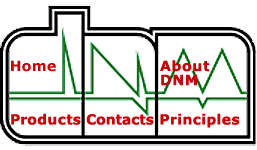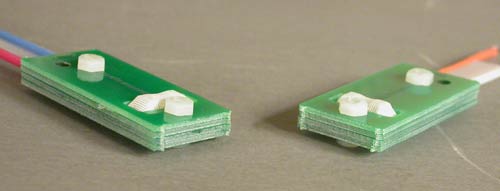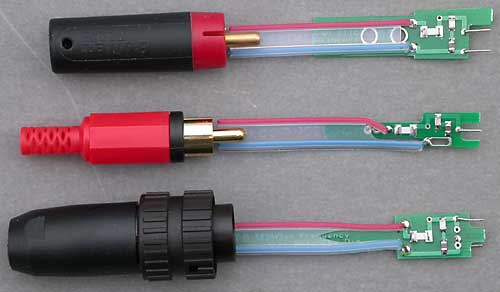

 |  |
|
ZRTN and HIGH FREQUENCY TERMINATION NETWORK (HFTN) Two new DNM products improve sound quality On this Page : Background ZRTN HFTN Interconnect HFTNs The NEW DNM ZRTN Background Audio cables are designed to carry signals in the audible frequency range from 20Hz to 20,000Hz. However cables can easily carry a wider frequency range, from below 20Hz up to and beyond the Super Audio CD (SACD) requirement of 50,000Hz (50kHz), double the highest frequency audible to humans.
The cable/amplifier problem When the cable is connected to an amplifier, it encounters even higher frequencies that cause significant degradation of the audio signal quality. Audio amplifiers drive RF (Radio Frequencies) as high as 100MHz into the cable which are high enough to stimulate the cables transmission-line effects. The RF signal is modified by resonances in the cable, then non-linearly processed by the amplifier feedback system, to produce audible interference. NB : Feedback is used in amplifiers to define gain and reduce distortion, it is generally accepted that it improves amplifier performance without adversely affecting sound quality. Easily measured evidence of the RF contribution of the cable is the large variation of its electrical impedance which swings sharply from less than ten Ohms to several thousand Ohms many times across the RF range. NB : Jim Lesurf confirmed this effect in his article "Taking the Lead" here. Uneven RF impedance, due to resonance, occurs in all interconnect and speaker cables. Each cable design has its own unique resonance pattern, so it degrades the amplifier signal in a specific way. Consequently all cables add some high frequency glare especially to digital signal sources, and all cables cause some loss of audio clarity. This complex interaction between cable and amplifier is the primary cause of the sound differences heard in audio cable comparisons, differences that are described by cable makers to be "the sound of the cable". Full Announcement of Speaker ZRTNs including revised use of HFTNs NEW DNM solution: the Zero Reflection Termination Network (ZRTN) The DNM ZRTN is an advanced second generation impedance termination network that makes the speaker cable almost invisible to the amplifier's internal feedback system. The ZRTN is fitted at the amplifier end of the speaker cable and it can be used alone or in conjunction with an HFTN at the speaker end of the cable, for ultimate performance. The ZRTN accurately terminates the speaker cable in the critical range of radio frequencies (RF) in which feedback amplifiers generate errors due to external interference, errors which adversely affect sound quality. It is difficult to make a truly sound-neutral series termination element for use in a hi-fi speaker cable. The element must handle very high current (over 25 amps), without running into saturation and handle frequencies up to 40MHz. The ZRTN became possible only after in-depth component research, followed by detailed evaluation of audio performance, to ensure that sound quality would not be lost in the quest to remedy the RF problems in feedback amplifiers. Our tests show that the DNM ZRTN improves every area of performance, with no losses caused by its insertion into the circuit. The ZRTN has the same current handling capability as DNM's heavy duty Resolution speaker cable, so the cable/ZRTN combination can be used with confidence that the technology has been applied to achieve a substantial gain in sound quality. Full connection information for ZRTNs An exploded view of the ZRTN PCB group is shown at the top of this page to show that it requires a complex assembly of parts to achieve very high performance filtering at very high frequencies. When assembled the ZRTN boards fit together in a tightly packed stack of 4 layers which is 8.4mm thick. The two inner layers are each 2.4mm thick double sided, thru-hole plated with gold plated surfaces and extra heavy copper. These boards are intricately shaped to hold the four 4mm sockets and accept copper inserts to enable 25 amp continuous current handling capacity. The two outer layers are used as component covers, one of them takes six press-in 3mm self-clinch nuts that allow the whole assembly to be held together. DNM solution : the High Frequency Termination Network (HFTN) 1. Speaker HFTNs  NEW : DNM HFTN wins award NEW : DNM HFTN wins award
 A pair of the larger SPEAKER HFTNs just announced. These work in parallel with your existing loudspeaker cables. These NEW HFTNs are very easy to fit because they work in parallel with your speaker cables. Full details of this new product here (This document is also linked from the HFTN page of our online shop). 2. Interconnect HFTNs  Three DNM HFTNs (the micro-PCBs) seen to the right of their matching plug types Interconnect HFTN - Limitations of use : The HFTN is designed to work with amplifier source impedances ranging from very low values up to 200 Ohms. Amplifiers with unusually high source impedance (e.g. valve types with 1000+ Ohms impedances) may not benefit from the Interconnect HFTN. Built on micro-PCBs, Interconnect HFTNs are small enough to fit inside the interconnect cable plugs. They can be assembled (only by DNM Design) onto existing DNM Stereo cables or fitted as an optional extra on new DNM Stereo cables. Each Interconnect HFTN costs £42-00 (inc. fitting), so the four HFTNs (required for a stereo interconnect cable) add £168-00 to the price of the cable and plugs. However, customers should find that the HFTN is excellent value because the sound improvement is substantial, so a DNM cable with HFTNs is unlikely to be equalled on sound quality by a non-terminated cable, even an extremely expensive one. Available from the DNM Online Shop, New Autumn Sale - now at 20% off :- HFTNs to fit all our interconnect plugs :- the three (RCA) phono plug types, the DIN plug and the (balanced) XLR connector. |
<< Previous Upgrading your DNM |
Next >> Capacitors |
 |
© DNM Design 2018 (Legal & Credits) |
| ||
|
>Products<
|
Contacts |
Principles |
||